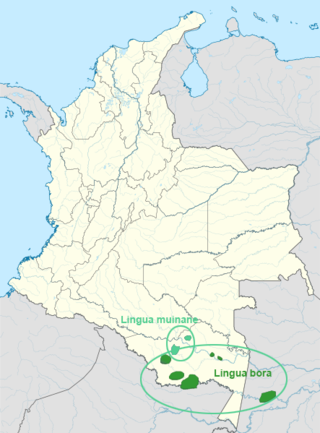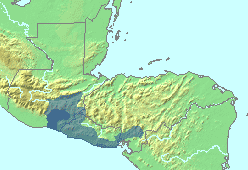
The Mayan languages form a language family spoken in Mesoamerica, both in the south of Mexico and northern Central America. Mayan languages are spoken by at least six million Maya people, primarily in Guatemala, Mexico, Belize, El Salvador and Honduras. In 1996, Guatemala formally recognized 21 Mayan languages by name, and Mexico recognizes eight within its territory.

Jutiapa Department is a department of Guatemala that borders along El Salvador and the Pacific Ocean. The capital is the city of Jutiapa. As of 2018, it has a population of 488,395. The department is divided into seventeen municipalities. Jutiapa is the country's southeasternmost department and officially the only department with no Mayan descendants native to the region. The main crops are sorghum, tobacco, onion and corn. The climate is dry. An important attraction is the cattle fair. It is at 405 m above sea level.

Mesoamerican languages are the languages indigenous to the Mesoamerican cultural area, which covers southern Mexico, all of Guatemala and Belize and parts of Honduras, El Salvador, Nicaragua and Costa Rica. The area is characterized by extensive linguistic diversity containing several hundred different languages and seven major language families. Mesoamerica is also an area of high linguistic diffusion in that long-term interaction among speakers of different languages through several millennia has resulted in the convergence of certain linguistic traits across disparate language families. The Mesoamerican sprachbund is commonly referred to as the Mesoamerican Linguistic Area.
Comecrudo is an extinct Pakawan language of Mexico. The name Comecrudo is Spanish for "eat-raw"; Carrizo is Spanish for "reed". It was best recorded in a list of 148 words in 1829 by French botanist Jean Louis Berlandier. It was spoken on the lower Rio Grande near Reynosa, Tamaulipas, in Mexico. Comecrudo has often been considered a Coahuiltecan language although most linguists now consider the relationship between them unprovable due to the lack of information.

Nueva Santa Rosa is a town and municipality in the Santa Rosa department of Guatemala. The municipality has a population of 36,464 and cover an area of 147 km2.

The Borôroan languages of Brazil are Borôro and the extinct Umotína and Otuke. They are sometimes considered to form part of the proposed Macro-Jê language family, though this has been disputed.

Boran is a small language family, consisting of just two languages.
The Xinka, or Xinca, are a non-Mayan indigenous people of Mesoamerica, with communities in the southern portion of Guatemala, near its border with El Salvador, and in the mountainous region to the north.
Lencan is a small family of nearly extinct indigenous Mesoamerican languages.
Mochoʼ is a Mayan language spoken by the Mocho' people of Chiapas, Mexico. A source stated that it was known as Qatok’, although this name has not received wide acceptance among the native speakers and the language, which is known as Mocho’ by both the Mocho’ people and the Mexican government. Mochoʼ has a dialect called Tuzantec (Muchu') spoken in Tuzantan, Chiapas. Alongside Jakaltek, Q’anjob’al, Chuj and Tojol-Ab’al, the Mocho’ language is part of the Q’anjobalan group from the western branch of Mayan languages.
Aikanã is an endangered language isolate spoken by about 200 Aikanã people in Rondônia, Brazil. It is morphologically complex and has SOV word order. Aikanã uses the Latin script. The people live with speakers of Koaia (Kwaza).

Harakmbut or Harakmbet is the native language of the Harakmbut people of Peru. It is spoken along the Madre de Dios and Colorado Rivers, in the pre-contact country of the people. There are two dialects that remain vital: Amarakaeri (Arakmbut) and Watipaeri (Huachipaeri), which are reported to be mutually intelligible. The relationship between speakers of the two dialects is hostile.

Spanish is the official language of Guatemala. Guatemalan Spanish is the local variant of the Spanish language.
Alagüilac is an undocumented indigenous American language that is thought to have been spoken by the Alaguilac people of Guatemala at the time of the Spanish conquest.
Payaguá (Payawá) is an extinct language of Paraguay, Argentina, and Bolivia, spoken by the Payaguá Indians. It is usually classified as one of the Guaicuruan languages, but the data is insufficient to demonstrate that.
Jumaytepeque is an extinct Xincan language of Guatemala that was spoken in the region of Jumaytepeque. It was discovered by Lyle Campbell in the 1970s.
Guazacapán is an extinct Xincan language that was spoken in the region of Guazacapán in Santa Rosa Department, Guatemala.
Chiquimulilla is an extinct Xincan language of Guatemala, from the region of Chiquimulilla.
Yupiltepeque is an extinct Xincan language of Guatemala, from the region of Yupiltepeque.
Sinacantán is an extinct Xincan language that was spoken in the region of Sinacantán in Santa Rosa Department, Guatemala. It is reported in Glottolog.








